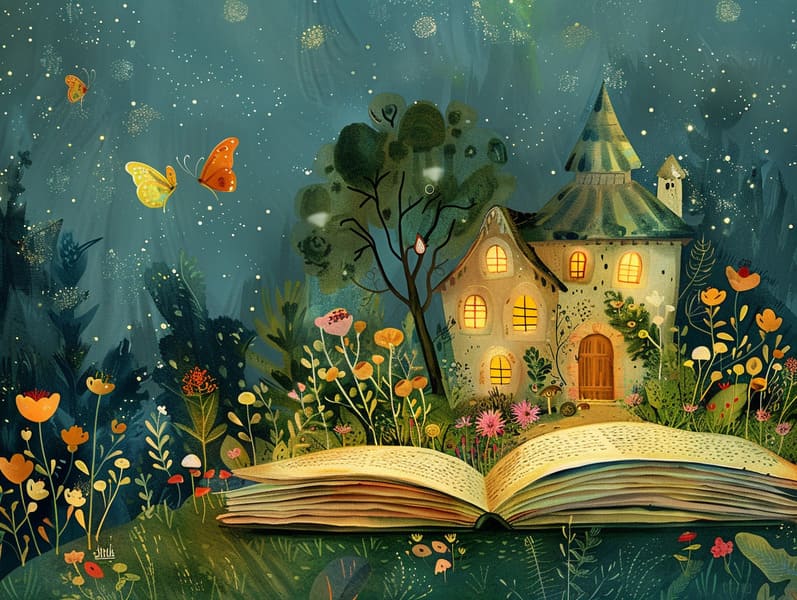
Historical fairy tales have timeless appeal. These stories have been shared from one generation to the next well before they were ever documented. They were born from a variety of traditions, including Middle Eastern traditions. They were initially narrated among older generations, often carrying themes and messages mirroring the societal norms and beliefs of the time.
The renowned Brothers Grimm, the two Grimm brothers, were among the first to collect and release many of these beloved stories. Their compilation, "Grimm's Children's Stories," included stories like "Cinder Maid," "The Story of Hansel and Gretel," and "Snow-White and Rose-Red," which have since become hallmarks in the world of timeless fairy tales. Similarly, Andersen's fantastical tales, such as "The Little Mermaid," and "The Duckling that Could," have touched hearts worldwide, establishing their place in the pantheon of treasured fairy tales.
Despite being ancient, these tales remain as impactful as ever, especially as nighttime stories for kids. These magical stories are now available in various formats, including artistically illustrated books, delightful animations, and online fairy tales.
Their unwavering allure can be traced to several charming aspects:
Moral Lessons: Classic fairy tales often convey important moral lessons. Tales like "The Boy Who Cried Wolf" teach the importance of honesty, while "The Tortoise and the Hare" highlight the qualities of steadfastness and humility. These stories offer little ones clear distinctions between moral and immoral, helping to shape their moral compass in a mild yet profound way.
Empathy and Understanding: Traditional fairy tales frequently feature heroes facing problems and hurdles, provoking audiences to identify with their struggles and support their triumphs. For instance, "Beauty and the Beast" conveys the value of looking deeper to see the true essence of a soul, nurturing empathy and insight.
Cultural Understanding: Many traditional fairy tales are saturated in the cultural contexts from which they bloomed. Understanding these narratives can provide illuminating insights into different traditions, advancing a sense of world insight and acknowledgment.
Fantasy and Innovation: The supernatural elements in fairy tales—spells and potions—revitalize children’s dreaming abilities. These fairy tales transport readers to fantasy realms, boosting fantastical thinking and a sense of curiosity that lasts a lifetime.
Classic fairy tales are not only charming but also edifying. They provide captivating tools in nurturing various cognitive and affective skills in kids. When ancient fairy tales are spoken out loud, they nurture language skills by offering new words and sophisticated sentence structures. This practice also improves hearing perception and attentiveness, as the young stay focused, excited to see what happens next.
Furthermore, contemplating the themes and characters of old fairy tales can promote analytical skills and cognitive skills. Kids are guided to notice patterns, foresee events, and catch on to cause and effect. These explorations also encourage little ones utter their thoughts and feelings, contributing to their emotional intelligence.
In today’s electronic age, the abundance of web-based fairy tales has made these tales more acquirable than ever. Web platforms and web apps make available extensive collections of children's fairy tales that can be enjoyed or listened via read more anytime, anywhere. Fairy tales spoken are particularly sought after, extending an immersive method for children to experience these enchanting tales. Audiobooks and read-to-me stories move characters and settings to life, often enhanced by charming melodies and instrumentals that improve the story journey.
The timeless charm of timeless fairy tales lies in their ability to adapt to new eras while maintaining their underlying messages. Contemporary revisions of these tales often include more representative characters and modern settings, making them understandable to today’s audience. However, the underlying themes of fortitude, benevolence, and impartiality remain unchanged, continuing to touch kids of all ages.
Old fairy tales also offer a sense of solace and recognition. They put out a well-arranged narrative with a obvious beginning, middle, and end, often wrapping up with the closure of conflicts and the triumph of morality over immorality. This predictability can be soothing for young readers, delivering a sense of sturdiness in an unpredictable world.
Classic fairy tales continue to entrance and train new generations, maintaining their grandeur and relevance in modern society. As bedtime stories for kids, they render a perfect blend of charm and enlightenment, promoting moral values, empathy, and creativity. The proliferation of digital fairy tales and the well-liked nature of fairy tales narrated certify that these classic narratives remain reachable to new generations.
By guarding and conveying these tales, we continue to praise the rich tapestry of fantasy and cultural heritage. Whether you are delving into a vibrantly illustrated book, perusing a internet library, or hearing an narrated book, the enchantment of bedtime fairy tales is always within reach. These fairy tales remind us of the steadfast power of storytelling and its ability to draw us together across epochs and places.
Even if you are experiencing a vibrantly illustrated book, perusing a virtual collection, or listening via an read-aloud book, the spell of famous fairy tales is always within reach.
These narratives emphasize of the continued influence of storytelling and its ability to unite us across eras and regions, weaving a spell that charms and informs alike.